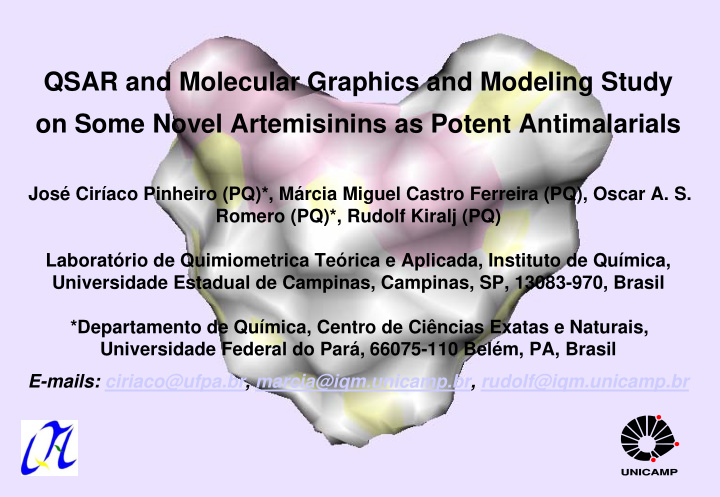



QSAR and Molecular Graphics and Modeling Study on Some Novel Artemisinins as Potent Antimalarials José Ciríaco Pinheiro (PQ)*, Márcia Miguel Castro Ferreira (PQ), Oscar A. S. Romero (PQ)*, Rudolf Kiralj (PQ) Laboratório de Quimiometrica Teórica e Aplicada, Instituto de Química, Universidade Estadual de Campinas, Campinas, SP, 13083-970, Brasil *Departamento de Química, Centro de Ciências Exatas e Naturais, Universidade Federal do Pará, 66075-110 Belém, PA, Brasil E-mails: ciriaco@ufpa.br, marcia@iqm.unicamp.br, rudolf@iqm.unicamp.br
A brief overview of what we have done in this work QSAR study on antimalarial artemisinins was performed by means of quantum chemical, chemometric and molecular graphics and modeling methods. Docking of some artemisinins to heme and hemoglobin was also carried out. The PLS model with four latent variables explaining 91.61% of logIC 50 variance ( Q 2 = 0.95 and R 2 = 0.96) was obtained. Molecular descriptors were LUMO+1 energy, atomic charges in C9 and C10, the maximum number of hydrogen atoms that might make contact with heme, and a WHIM-3D index related to molecular symmetry. Two from ten proposed artemisinin derivatives were predicted with antimalarial activity higher than the compounds reported in literature. Docking results confirmed the PLS results and gave more insight into the nature of heme-artemisinin and heme-hemoglobin interactions.
How does artemisinin look like??? Artemisinin: A new compound whose derivatives represent a novel class of potent antimalarials. The malarial microorganism Plasmodium Falciparum has already exhibited resistance to known antimalarials, but not to artemisinins. Space filling (CPK) models 2 D scheme 3D stick model
Artemisinins under study – the training set (17 molecules)
Artemisinins under study – the prediction set (10 molecules)
What are the objectives of this study? -to propose new antimalarial artemisinins with predicted high activity – if possible, with activity higher than those clinically in use -> QSAR study -to give more insight into artemisinin, heme and artemisini-heme complex properties and heme-artemisinin interaction -> QSAR study, molecular graphics and modeling, other supporting methodologies (chemometric, data mining, structural comparisons etc.)
What were the QSAR/chemometric methods used in this work? QSAR: -> biological activities from literature (Acton et al , J Med Chem 36 (1993) 2552; Acton et al , Planta Med 53 (1987) 266.) -> molecular descriptors: -> quantum chemical (HF 6-31G**): -> MO energy, E LUMO+1 -> charge at C9, Q 9 -> charge at C10, Q 10 -> topological-structural: -> the number of H-atoms in contact with heme, N H -> electrotopological: -> an index from WHIM-3D, symmetry-related, G1e -> regression method: -> PLS (Partial Least Squares), autoscaled data, leave-1-out crossvalidation Chemometrics: -> HCA (Hierarquical Cluster Analysis), autoscaled data, incremental linkage -> PCA (Principal Component Analysis), autoscaled data
What were other methods used in this work? Molecular graphics and modeling: -> steric and electronic complementarity of artemisinin with heme -> docking of artemisinin to heme -> MMFF94 conformational study around Fe-O1 bond -> docking of artemisinin to hemoglobin A monomer -> MMFF94 Data mining and structural study: -> retrieval of relevant structures from CSD (Cambridge Structural Database) and PDB (Protein Data Bank) -> comparison of the retrieved structures with those from docking
QSAR results <- biological activities for <- QSAR data for the training set the prediction set PLS model: Q 2 =.95, R 2 = 0.96, with 3 PCs (91.61% total variance explained)
More QSAR/chemometric results PLS plot: predicted vs . measured A PCA scores plot: PC1 vs . PC2. activities
More chemometrics results A PCA loadings plot: PC1 vs . PC2. HCA dendogram of samples
Some molecular graphics & modeling results (docking) Substrat-heme-proximal histidine complexes ART_24-heme-proximal histidine optimized by MMFF94 after the Fe-O complex surrounded by conformational study hemoglobin amino-acids
More molecular graphics & modeling results (docking) Artemisinins (green) and heme (yellow) as can be seen in a view towards the hemoglobin surface. The green area is proportional to the biological activity for these compounds.
Data mining & structural studies Substrate-heme-proximal histidine complex surrounded by residues of hemoglobin. Retrievals from PDB. Polar-polar and hydrophobic-hydrophobic interactions are visible.
More data mining & structural studies Substrate-heme complexes retrieved Preference for polar (green), from PDB. Orientation of the substrate hydrophobic (rose) or any (gray) with respect to heme is determined by substrate groups to interact with distribution of polar and hydrophobic heme. groups in the molecules.
At the end, we can conclude that… …the artemisinins are mainly grouped as low, moderately and highly active compounds (see the HCA, PCA, PLS plots) …the fairly good PLS model predicts ART_ 24 and ART_ 27 to be more active than the compoundsreported in literature (see the tables) …the torsion angle O2-O1-Fe-C( meso ) in minimum energy artemisinin-heme- proximal histidine complexes ranges from -105º to -135º, what could be expected as a general behavior of artemisinins (see color figures from the modeling&graphics part) …the artemisinin orientation with respect to heme is determined by polar-polar and hydrophobic-hydrophobic interactions between artemisinin, heme and amino-acid residues (see color figures from the modeling&graphics&structural part) …the highly active artemisinins possess suitable substituents at C9 and C10 which are able to reach the hemoglobin exterior (see color figures from the modeling&graphics&structural part) Thanks! to FAPESP for the financial support.
Recommend
More recommend